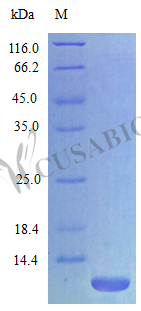The recombinant Rat C-X-C motif chemokine 3 protein (Cxcl3) comes from an E. coli expression system and covers amino acids 33-97, along with an added proline-serine-leucine sequence. This tag-free protein shows purity levels above 96% when checked through SDS-PAGE analysis. Testing confirms the protein remains fully biologically active—chemotaxis bioassays indicate activity between 5-50 ng/ml concentrations. Endotoxin levels stay below 1.0 EU/µg according to LAL method measurements.
Cxcl3 appears to play a key role in immune responses, mainly by recruiting and activating neutrophils. The protein seems to work through specific cell surface receptors like CXCR2 to trigger chemotactic signaling pathways. Because of its involvement in immune cell movement, Cxcl3 has become an important target for researchers studying inflammation and immune system regulation. Understanding how this protein works may help explain the broader mechanisms that control immune responses.
Potential Applications
Note: The applications listed below are based on what we know about this protein's biological functions, published research, and experience from experts in the field. However, we haven't fully tested all of these applications ourselves yet. We'd recommend running some preliminary tests first to make sure they work for your specific research goals.
1. Neutrophil Chemotaxis Assays
This recombinant rat CXCL3 is confirmed to be biologically active via human CXCR2 (active at 5-50 ng/ml) and suitable for neutrophil migration studies. However, researchers should validate its activity on primary neutrophils rather than relying solely on transfected BaF3 cell data. The high purity (>96%) supports reliable results, but optimal concentrations may need adjustment for primary cells due to potential differences in receptor expression and signaling. Cross-species comparisons should account for possible affinity differences between rat CXCL3 and human/rat CXCR2 interactions.
2. CXCR2 Receptor Binding Studies
The protein is appropriate for CXCR2 binding studies, but the partial sequence (33-97aa) and "PSL" modification may affect binding kinetics compared to full-length CXCL3. Binding assays should include full-length CXCL3 as a reference to determine if the truncated form maintains native binding characteristics. The demonstrated activity confirms receptor engagement, but affinity measurements may not fully represent endogenous protein-receptor interactions.
3. Inflammatory Response Modeling in Preclinical Studies
This CXCL3 can be used in inflammatory models, but the partial sequence may alter function in complex physiological environments. Researchers should validate that the truncated protein elicits appropriate neutrophil recruitment and inflammatory responses in rat tissues, as the absence of full-length protein domains might affect gradient formation and stability in vivo.
4. Antibody Development and Validation
This partial CXCL3 (33-97aa) serves as a limited antigen for antibody development. Antibodies may not recognize epitopes outside the expressed region, potentially missing important domains of full-length CXCL3. Validation should include testing against full-length protein and native CXCL3 from inflammatory sources to ensure comprehensive epitope coverage.
5. Chemokine Signaling Pathway Analysis
The protein is suitable for CXCR2 signaling studies, but the partial sequence and non-mammalian expression may affect signaling amplitude or duration. Researchers should compare signaling pathways activated by this recombinant protein with those induced by native CXCL3 to confirm physiological relevance, particularly for downstream events like calcium mobilization and kinase activation.
Final Recommendation & Action Plan
This recombinant rat CXCL3 partial protein (33-97aa+PSL) demonstrates confirmed bioactivity through human CXCR2, making it suitable for preliminary CXCR2-focused studies. However, the partial nature requires careful validation: First, confirm that the truncation and PSL modification do not alter receptor binding affinity or signaling potency compared to full-length CXCL3. Second, establish activity in primary neutrophil systems rather than relying solely on transfected cell lines. For antibody development, this protein is adequate for generating domain-specific antibodies but should be supplemented with a full-length antigen for comprehensive coverage. The high purity and low endotoxin support cell-based applications, but researchers should note that the bacterial expression system produces a non-glycosylated protein that may behave differently from native CXCL3 in some contexts. Always include appropriate controls with full-length protein when studying complex biological functions, and consider the potential impact of the partial sequence on in vivo applications where protein stability and interactions may differ from reduced systems.






